2014 FIAT 500L LIVING clutch
[x] Cancel search: clutchPage 176 of 420
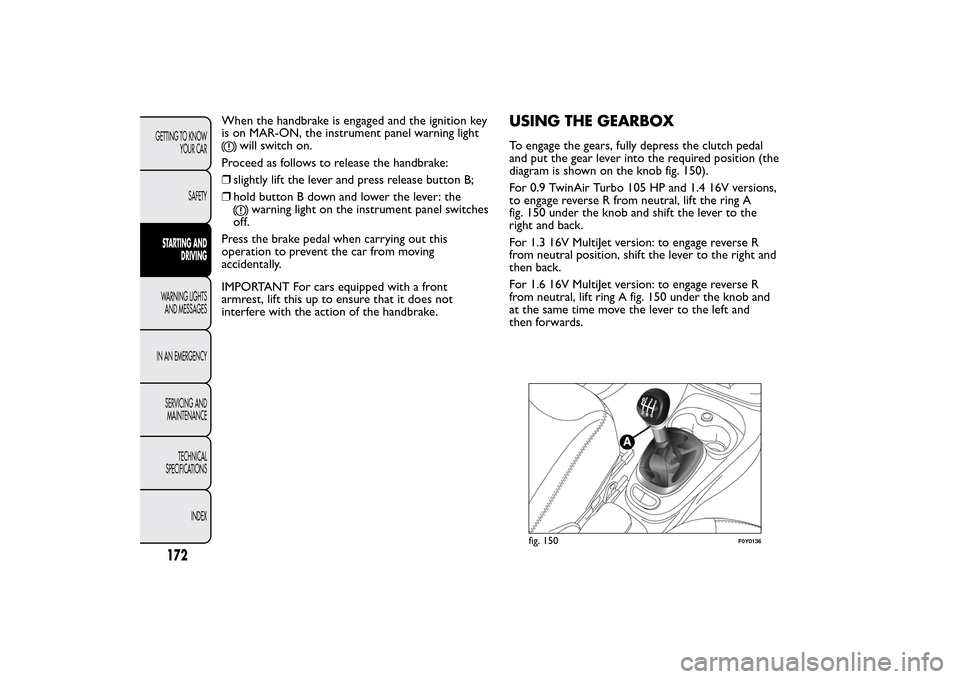
When the handbrake is engaged and the ignition key
is on MAR-ON, the instrument panel warning light
will switch on.
Proceed as follows to release the handbrake:
❒slightly lift the lever and press release button B;
❒hold button B down and lower the lever: the
warning light on the instrument panel switches
off.
Press the brake pedal when carrying out this
operation to prevent the car from moving
accidentally.
IMPORTANT For cars equipped with a front
armrest, lift this up to ensure that it does not
interfere with the action of the handbrake.
USING THE GEARBOXTo engage the gears, fully depress the clutch pedal
and put the gear lever into the required position (the
diagram is shown on the knob fig. 150).
For 0.9 TwinAir Turbo 105 HP and 1.4 16V versions,
to engage reverse R from neutral, lift the ring A
fig. 150 under the knob and shift the lever to the
right and back.
For 1.3 16V MultiJet version: to engage reverse R
from neutral position, shift the lever to the right and
then back.
For 1.6 16V MultiJet version: to engage reverse R
from neutral, lift ring A fig. 150 under the knob and
at the same time move the lever to the left and
then forwards.
fig. 150
F0Y0136
172GETTING TO KNOW
YOUR CAR
SAFETYSTARTING AND
DRIVINGWARNING LIGHTS
AND MESSAGES
IN AN EMERGENCY
SERVICING AND
MAINTENANCE
TECHNICAL
SPECIFICATIONS
INDEX
Page 177 of 420
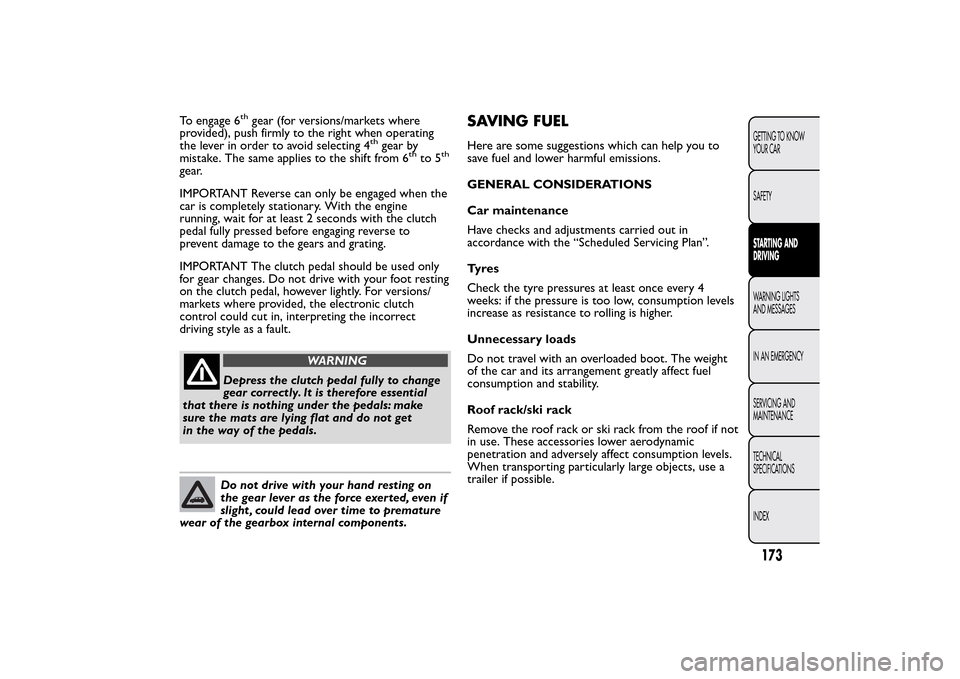
To engage 6
th
gear (for versions/markets where
provided), push firmly to the right when operating
the lever in order to avoid selecting 4
th
gear by
mistake. The same applies to the shift from 6
th
to 5
th
gear.
IMPORTANT Reverse can only be engaged when the
car is completely stationary. With the engine
running, wait for at least 2 seconds with the clutch
pedal fully pressed before engaging reverse to
prevent damage to the gears and grating.
IMPORTANT The clutch pedal should be used only
for gear changes. Do not drive with your foot resting
on the clutch pedal, however lightly. For versions/
markets where provided, the electronic clutch
control could cut in, interpreting the incorrect
driving style as a fault.
WARNING
Depress the clutch pedal fully to change
gear correctly. It is therefore essential
that there is nothing under the pedals: make
sure the mats are lying flat and do not get
in the way of the pedals.Do not drive with your hand resting on
the gear lever as the force exerted, even if
slight , could lead over time to premature
wear of the gearbox internal components.
SAVING FUELHere are some suggestions which can help you to
save fuel and lower harmful emissions.
GENERAL CONSIDERATIONS
Car maintenance
Have checks and adjustments carried out in
accordance with the “Scheduled Servicing Plan”.
Ty r e s
Check the tyre pressures at least once every 4
weeks: if the pressure is too low, consumption levels
increase as resistance to rolling is higher.
Unnecessary loads
Do not travel with an overloaded boot. The weight
of the car and its arrangement greatly affect fuel
consumption and stability.
Roof rack/ski rack
Remove the roof rack or ski rack from the roof if not
in use. These accessories lower aerodynamic
penetration and adversely affect consumption levels.
When transporting particularly large objects, use a
trailer if possible.
173GETTING TO KNOW
YOUR CAR
SAFETYSTARTING AND
DRIVINGWARNING LIGHTS
AND MESSAGES
IN AN EMERGENCY
SERVICING AND
MAINTENANCE
TECHNICAL
SPECIFICATIONS
INDEX
Page 178 of 420

Electrical devices
Only use electrical devices for the amount of time
needed. The heated rear window, additional
headlights, windscreen/rear window wipers and
heater fan need a considerable amount of energy,
therefore increasing fuel consumption (by up to 25%
in the urban cycle).
Climate control system
The use of the climate control system leads to higher
fuel consumption. If the temperature outside
permits, try to use ventilation only.
Devices for aerodynamic control
The use of non-certified devices for aerodynamic
control may adversely affect air drag and fuel
consumption.
DRIVING STYLE
Starting
Do not warm up the engine at low or high revs when
the car is stationary; this causes the engine to warm
up more slowly, thereby increasing fuel consumption
and emissions.
It is advisable to set off immediately and slowly,
avoiding high revs: this allows the engine to warm up
more quickly.Unnecessary actions
Avoid revving up when at traffic lights or before
stopping the engine. This and also double declutching
is absolutely pointless on modern cars and also
increases consumption and pollution.
Gear selection
Use a higher gear as soon as traffic and road
conditions allow. Using a low gear for faster
acceleration will increase consumption.
In the same way improper use of a high gear
increases consumption, emissions and engine wear.
Maximum speed
Fuel consumption increases considerably with speed.
Keep speed as constant as possible, avoiding
unnecessary braking and acceleration, which have a
significant cost in terms of both fuel consumption
and emissions.
Acceleration
Sudden acceleration has a very negative effect on fuel
consumption and emissions: accelerate gradually.
174GETTING TO KNOW
YOUR CAR
SAFETYSTARTING AND
DRIVINGWARNING LIGHTS
AND MESSAGES
IN AN EMERGENCY
SERVICING AND
MAINTENANCE
TECHNICAL
SPECIFICATIONS
INDEX
Page 243 of 420
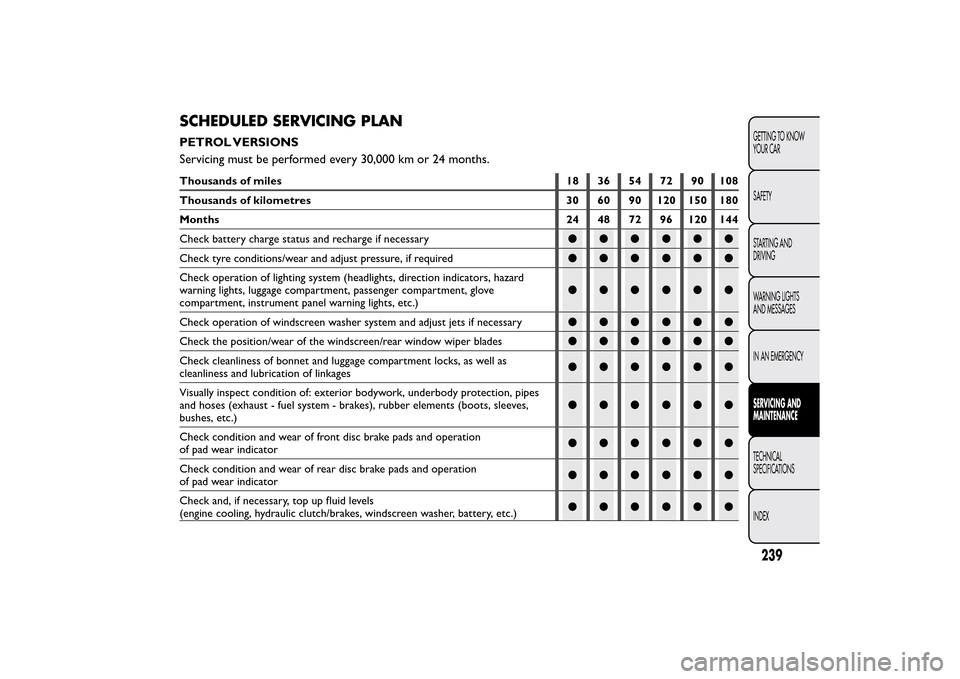
SCHEDULED SERVICING PLANPETROL VERSIONS
Servicing must be performed every 30,000 km or 24 months.Thousands of miles 18 36 54 72 90 108
Thousands of kilometres 30 60 90 120 150 180
Months 24 48 72 96 120 144
Check battery charge status and recharge if necessary●●●●●●
Check tyre conditions/wear and adjust pressure, if required●●●●●●
Check operation of lighting system (headlights, direction indicators, hazard
warning lights, luggage compartment, passenger compartment, glove
compartment, instrument panel warning lights, etc.)●●●●●●
Check operation of windscreen washer system and adjust jets if necessary●●●●●●
Check the position/wear of the windscreen/rear window wiper blades●●●●●●
Check cleanliness of bonnet and luggage compartment locks, as well as
cleanliness and lubrication of linkages●●●●●●
Visually inspect condition of: exterior bodywork, underbody protection, pipes
and hoses (exhaust - fuel system - brakes), rubber elements (boots, sleeves,
bushes, etc.)●●●●●●
Check condition and wear of front disc brake pads and operation
of pad wear indicator●●●●●●
Check condition and wear of rear disc brake pads and operation
of pad wear indicator●●●●●●
Check and, if necessary, top up fluid levels
(engine cooling, hydraulic clutch/brakes, windscreen washer, battery, etc.)●●●●●●
239GETTING TO KNOW
YOUR CAR
SAFETY
STARTING AND
DRIVING
WARNING LIGHTS
AND MESSAGES
IN AN EMERGENCYSERVICING AND
MAINTENANCETECHNICAL
SPECIFICATIONS
INDEX
Page 246 of 420

DIESEL VERSIONS
Servicing must be carried out every 35,000 km or 24 months.Thousands of miles 21 42 63 84 105
Thousands of kilometres 35 70 105 140 175
Months 24 48 72 96 120
Check battery charge status and recharge if necessary●●●●●
Check tyre conditions/wear and adjust pressure, if required●●●●●
Check operation of lighting system (headlights, direction indicators, hazard
warning lights, luggage compartment, passenger compartment, glove
compartment, instrument panel warning lights, etc.)●●●●●
Check operation of windscreen wiper/washer system and adjust jets, if
necessary●●●●●
Check the position/wear of the windscreen/rear window wiper blades●●●●●
Check cleanliness of bonnet and luggage compartment locks, as well as
cleanliness and lubrication of linkages●●●●●
Visually inspect condition of: exterior bodywork, underbody protection, pipes
and hoses (exhaust - fuel system - brakes), rubber elements (boots, sleeves,
bushes, etc.)●●●●●
Check condition and wear of front disc brake pads and operation of pad wear
indicator●●●●●
Check condition and wear of rear disc brake pads and operation of pad wear
indicator●●●●●
Check and, if necessary, top up fluid levels (engine cooling, hydraulic clutch/
brakes, windscreen washer, battery, etc.)●●●●●
Visual check of accessory drive belt(s) (versions without automatic tensioner)●
242GETTING TO KNOW
YOUR CAR
SAFETY
STARTING AND
DRIVING
WARNING LIGHTS
AND MESSAGES
IN AN EMERGENCYSERVICING AND
MAINTENANCE
TECHNICAL
SPECIFICATIONS
INDEX
Page 272 of 420
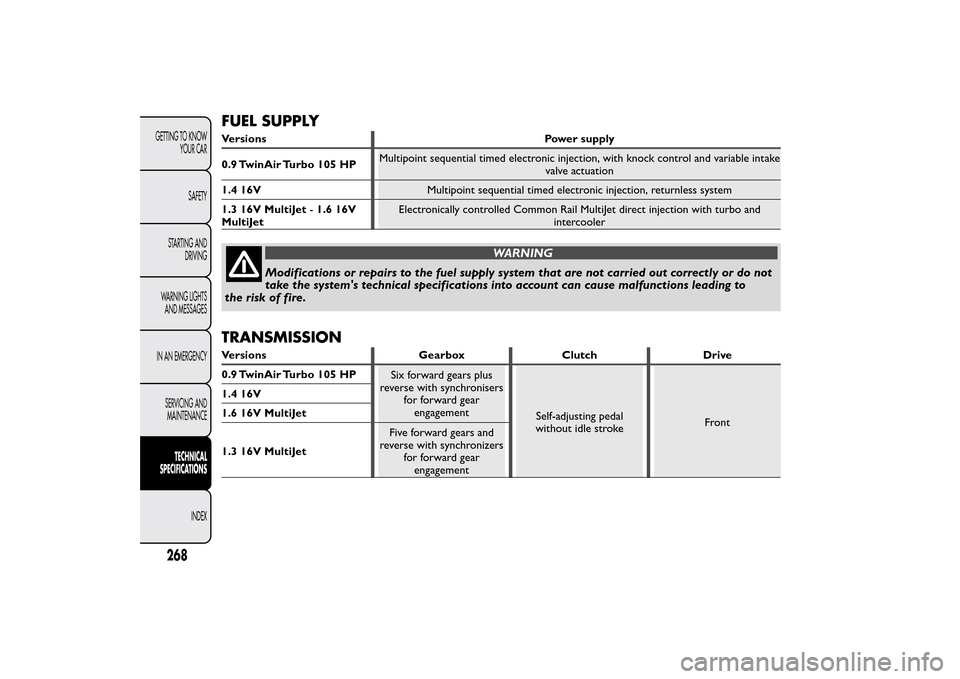
FUEL SUPPLYVersions Power supply
0.9 TwinAir Turbo 105 HPMultipoint sequential timed electronic injection, with knock control and variable intake
valve actuation
1.4 16VMultipoint sequential timed electronic injection, returnless system
1.3 16V MultiJet-1.6 16V
MultiJetElectronically controlled Common Rail MultiJet direct injection with turbo and
intercooler
WARNING
Modifications or repairs to the fuel supply system that are not carried out correctly or do not
take the system's technical specifications into account can cause malfunctions leading to
the risk of fire.
TRANSMISSIONVersions Gearbox Clutch Drive
0.9 TwinAir Turbo 105 HP
Six forward gears plus
reverse with synchronisers
for forward gear
engagement
Self-adjusting pedal
without idle strokeFront 1.4 16V
1.6 16V MultiJet
1.3 16V MultiJetFive forward gears and
reverse with synchronizers
for forward gear
engagement
268GETTING TO KNOW
YOUR CAR
SAFETY
STARTING AND
DRIVING
WARNING LIGHTS
AND MESSAGES
IN AN EMERGENCY
SERVICING AND
MAINTENANCE
TECHNICAL
SPECIFICATIONS
INDEX
Page 290 of 420

UseFluid and lubricant features for a correct
use of the carGenuine fluids and
lubricantsApplications
Lubricants and
greases for
motion
transmissionSAE 75W grade synthetic lubricant. FIAT
Classification 9.55550-MZ6TUTELA
TRANSMISSION
GEARFORCE
Contractual Technical
Reference No. F002.F10Mechanical gearbox
and differential
Molybdenum disulphide grease, for use at high
temperatures. Consistency NL.G.I. 1-2. FIAT
Classification 9.55580TUTELA ALL STAR
Contractual Technical
Reference No. F702.G07Wheel side constant
velocity joints
Grease for constant velocity joints with low
friction coefficient. Consistency NL.G.I. 0-1.
FIAT Classification 9.55580TUTELA STAR 700
Contractual Technical
Reference No. F701.C07Differential side
constant velocity
joints
Brake fluidSynthetic fluid for brake and clutch systems.
Exceeds specifications: FMVSS no. 116 DOT 4,
ISO 4925 SAE J1704 FIAT Classification
9.55597TUTELA TOP 4
Contractual Technical
Reference No. F001.A93Hydraulic brakes and
hydraulic clutch
controls
286GETTING TO KNOW
YOUR CAR
SAFETY
STARTING AND
DRIVING
WARNING LIGHTS
AND MESSAGES
IN AN EMERGENCY
SERVICING AND
MAINTENANCE
TECHNICAL
SPECIFICATIONS
INDEX
Page 412 of 420
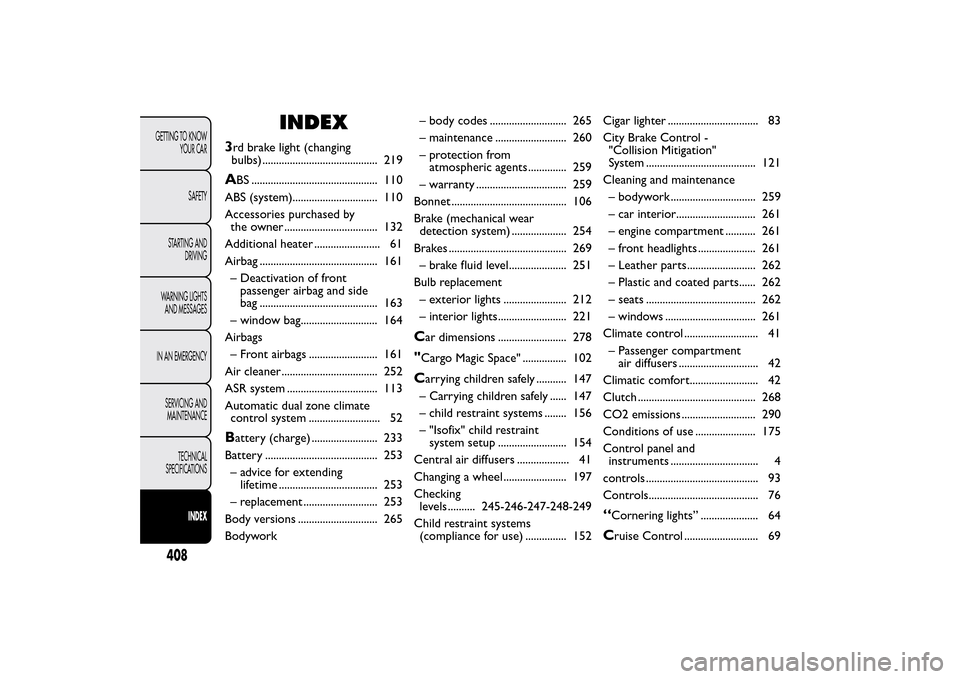
INDEX
3rd brake light (changing
bulbs) .......................................... 219A
BS .............................................. 110
ABS (system)............................... 110
Accessories purchased by
the owner .................................. 132
Additional heater ........................ 61
Airbag ........................................... 161
– Deactivation of front
passenger airbag and side
bag ........................................... 163
– window bag............................ 164
Airbags
– Front airbags ......................... 161
Air cleaner ................................... 252
ASR system ................................. 113
Automatic dual zone climate
control system .......................... 52
Battery (charge) ........................ 233
Battery ......................................... 253
– advice for extending
lifetime .................................... 253
– replacement ........................... 253
Body versions ............................. 265
Bodywork– body codes ............................ 265
– maintenance .......................... 260
– protection from
atmospheric agents.............. 259
– warranty ................................. 259
Bonnet .......................................... 106
Brake (mechanical wear
detection system) .................... 254
Brakes ........................................... 269
– brake fluid level..................... 251
Bulb replacement
– exterior lights ....................... 212
– interior lights......................... 221
Car dimensions ......................... 278"Cargo Magic Space" ................ 102Carrying children safely ........... 147
– Carrying children safely ...... 147
– child restraint systems ........ 156
– "Isofix" child restraint
system setup ......................... 154
Central air diffusers ................... 41
Changing a wheel ....................... 197
Checking
levels .......... 245-246-247-248-249
Child restraint systems
(compliance for use) ............... 152Cigar lighter ................................. 83
City Brake Control -
"Collision Mitigation"
System ........................................ 121
Cleaning and maintenance
– bodywork ............................... 259
– car interior............................. 261
– engine compartment ........... 261
– front headlights ..................... 261
– Leather parts......................... 262
– Plastic and coated parts...... 262
– seats ........................................ 262
– windows ................................. 261
Climate control ........................... 41
– Passenger compartment
air diffusers ............................. 42
Climatic comfort......................... 42
Clutch ........................................... 268
CO2 emissions ........................... 290
Conditions of use ...................... 175
Control panel and
instruments ................................ 4
controls ......................................... 93
Controls........................................ 76
“Cornering lights” ..................... 64Cruise Control ........................... 69
408GETTING TO KNOW
YOUR CAR
SAFETY
STARTING AND
DRIVING
WARNING LIGHTS
AND MESSAGES
IN AN EMERGENCY
SERVICING AND
MAINTENANCE
TECHNICAL
SPECIFICATIONS
INDEX